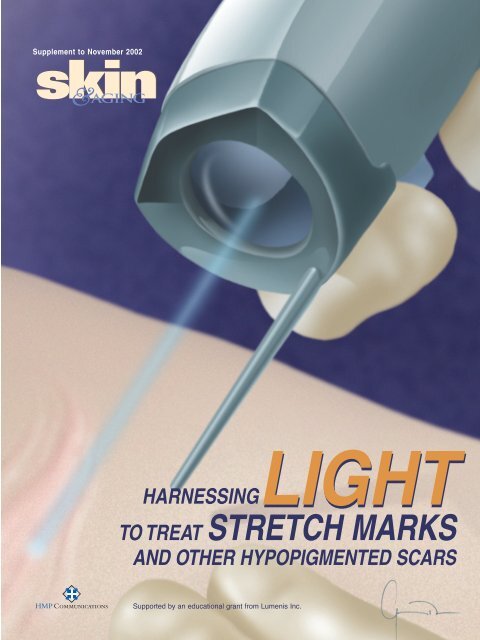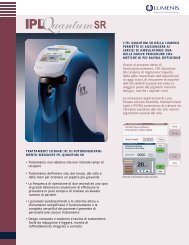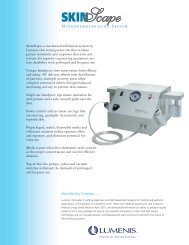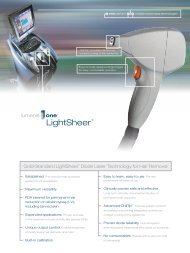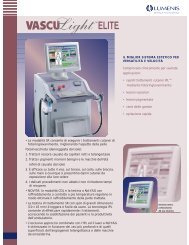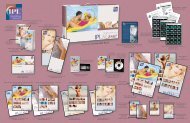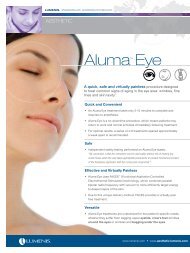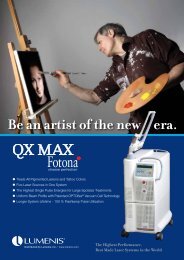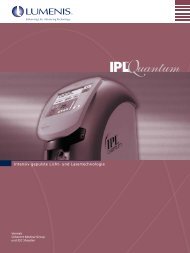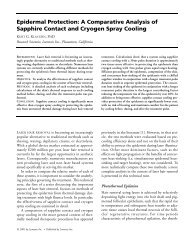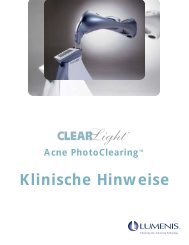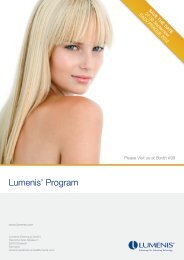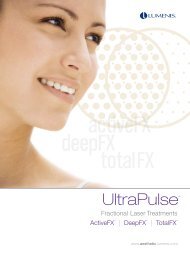Skin - Lumenis Aesthetic
Skin - Lumenis Aesthetic
Skin - Lumenis Aesthetic
Create successful ePaper yourself
Turn your PDF publications into a flip-book with our unique Google optimized e-Paper software.
Supplement to November 2002<br />
skin<br />
&AGING<br />
LIGHT<br />
HARNESSINGLIGHT<br />
TO TREAT STRETCH MARKS<br />
AND OTHER HYPOPIGMENTED SCARS<br />
HMP Communications<br />
Supported by an educational grant from <strong>Lumenis</strong> Inc.
HARNESSINGLIGHT<br />
TO TREAT STRETCH MARKS<br />
AND OTHER HYPOPIGMENTED SCARS<br />
New research highlights successes in repigmenting mature<br />
stretch marks and hypopigmented scars.<br />
Stretch marks, or striae distensae, occur very commonly and create<br />
significant cosmetic skin disfigurement. These marks affect a large<br />
portion of the population. It’s reported that approximately 90% of<br />
pregnant women, 70% of adolescent females and 40% of adolescent<br />
males have stretch marks. 1 In men, striae typically occur as a result of a<br />
rapid growth spurt or weight gain at puberty, from endocrine disorders<br />
or as a consequence of participation in certain sports, especially<br />
weightlifting. Excessive or chronic use of potent topical<br />
or systemic corticosteroids also promotes the formation<br />
of striae. 2 Although frequently classified into two<br />
types, early (red) and mature (white or alba), striae<br />
represent linear dermal scars accompanied by epidermal<br />
atrophy. While the use of lasers or light<br />
treatments to diminish the appearance of striae<br />
has been reported by a number of sources,<br />
controlled clinical studies are rare. New evidence<br />
suggests that targeted light therapy<br />
may have a significant benefit. We believe<br />
that the hypopigmented component of striae<br />
can be safely treated with targeted 290<br />
nm to 400 nm ultraviolet (UV) light. The<br />
improvement may be enhanced in combination<br />
with other therapeutic modalities that<br />
aid in collagen remodeling in order to<br />
achieve safe and effective improvement in the<br />
appearance of striae distensae.<br />
In this article, we’ll focus on the use of a novel targeted<br />
incoherent UV light source, the ReLume<br />
1 S UPPLEMENT TO S KIN & AGING<br />
The <strong>Lumenis</strong> ReLume Repigmentation Phototherapy System
Hypopigmented traumatic scar before (at left) and after eight ReLume treatments (at right).<br />
Photos courtesy of Dr. Roy Geronemus & Dr. Macrene Alexiades-Armenakas<br />
Repigmentation Phototherapy System (<strong>Lumenis</strong>,<br />
Inc., Santa Clara, CA), for treating mature striae and<br />
other hypopigmented non-linear dermal scars. First,<br />
we’ll review the etiology of striae and discuss other<br />
treatments that have been employed to diminish<br />
their appearance.<br />
ETIOLOGY<br />
The factors that lead to the development of striae<br />
are poorly understood. Early changes include inflammation<br />
and capillary dilation. It is believed<br />
that stress shattering of the collagen<br />
framework initiates an inflammatory<br />
response that ultimately<br />
results in a thin and flattened<br />
epidermis with loss of the rete<br />
ridges and loss of melanocytes.<br />
Elastic stains show breakage and<br />
retraction of the elastic<br />
fibers in the<br />
reticular<br />
dermis. 3, 4 Other dermal<br />
changes include thin, densely packed<br />
collagen bundles arranged in a parallel array horizontal<br />
to the epidermis at the level of the papillary<br />
dermis. Extracellular matrix alterations that mediate<br />
the clinical appearance of stretch marks remain poorly<br />
understood. With time, striae assume their typical<br />
white atrophic appearance with the long axis aligned<br />
parallel to the lines of skin tension. According to<br />
McDaniel, this development is very similar to that of<br />
surgical wound healing. 5<br />
A REVIEW OF TOPICAL TREATMENTS FOR STRIAE<br />
Improvement in the appearance of striae by topical<br />
agents has been aggressively sought for many years.<br />
Topical tretinoin in a 0.1% concentration has been<br />
shown to be effective for striae rubra or early, red,<br />
inflammatory stretch marks. 6 However, it failed to significantly<br />
improve mature stretch marks (striae alba). 7<br />
Whether the improvement of striae rubra leads to a<br />
diminution in the final appearance of the striae<br />
remains unknown. Recent data suggests that the application<br />
of 20% glycolic acid (MD Forte, Allergan) with<br />
either 0.05% tretinoin emollient cream (Renova,<br />
Ortho Pharmaceuticals) or 10%<br />
L-ascorbic acid (<strong>Skin</strong>Ceuticals) on<br />
a daily basis may slightly improve<br />
the appearance of striae alba. 8 In<br />
general, topical treatments have<br />
yielded disappointing results with<br />
only modest improvement reported<br />
in mature striae.<br />
LASER/ INTENSE PULSED LIGHT (IPL)<br />
TREATMENT OF STRIAE<br />
Many lasers including the CO2,<br />
Erbium:YAG, 1320 nm Nd:YAG and<br />
pulsed dye lasers have been used to treat<br />
scars and stretch marks. 9,10 Many have also<br />
used Intense Pulsed Light (IPL) with filters<br />
ranging from 550 nm to 590 nm, but<br />
no controlled trials have been performed.<br />
IPL induces some improvement of the erythematous<br />
component of new striae; however,<br />
the effects on mature striae are uncertain<br />
and have not been thoroughly studied.<br />
Handpiece for the ReLume system.<br />
2
Pulsed dye laser therapy has been shown to improve all types<br />
of striae, but red, early striae improve more dramatically while<br />
white mature striae are less responsive. The optimal fluence<br />
was determined to be 3 J/cm 2 using a 10-mm spot size. This<br />
study also revealed that laser therapy of striae requires<br />
patience with continual improvement observed 6 to 12 months<br />
after treatment. 11 Using similar pulsed dye laser treatment<br />
methods, other investigators failed to note much clinical or<br />
histological improvement of striae. 12,13 The 1320 nm Nd:YAG<br />
dynamically cooled laser has been demonstrated to produce<br />
modest improvement (about 10% per treatment) in the texture<br />
of mature striae. 14 Therefore, lasers and light sources have<br />
not achieved consistent success nor has the mature hypopigmented<br />
component of striae been specifically addressed.<br />
LIGHT-BASED TREATMENT OF HYPOPIGMENTED SCARS<br />
We have had initial success treating hypopigmented scars<br />
using the ReLume Repigmentation Phototherapy System,<br />
which combines the benefits of safe and effective UV phototherapy<br />
with the latest advances in targeted light technology.<br />
Pilot clinical investigations with approximately 50 patients<br />
from our centers combined have shown repigmentation in<br />
approximately 80% of patients within a 2- to 3-month period,<br />
with a total number of treatments up to 14. Treatment fluences<br />
are initially administered at or slightly below the erythemogenic<br />
threshold and the dose is increased as patients<br />
become more photo-tolerant. The induction and retention of<br />
pigmentation varies somewhat and may depend on several factors<br />
including the individual’s skin phototype, the body site<br />
treated and the type and age of the lesion. However, marked<br />
improvement is commonly observed beyond 3 months post<br />
treatment. These clinical trials are ongoing and the outcomes<br />
reported here represent very early clinical results.<br />
Scars treated with this light source have varied from surgical<br />
incisions to the hypopigmentation seen as a late side effect of<br />
CO2 laser resurfacing. Excimer laser phototherapy and topical<br />
photochemotherapy have also been used to provide moderately<br />
to highly effective repigmentation of laser resurfacinginduced<br />
leukoderma. 15,16<br />
An example of traumatic surgical scar repigmentation is<br />
shown in the photos on the previous page. This patient’s scar<br />
acquired robust pigmentation in eight ReLume treatments,<br />
performed weekly to bi-weekly with a fluence of 260 mJ/cm 2 .<br />
Treatment times are short, and coverage of large areas can be<br />
achieved quickly using a delivery spot of adjustable size and<br />
shape. A spacer on the handpiece allows the practitioner to visualize<br />
the treatment field to improve the accuracy of treatments.<br />
LIGHT-BASED TREATMENT<br />
OF MATURE HYPOPIGMENTED STRIAE ALBA<br />
Striae assume their typical white sunken appearance in a<br />
Contributing Authors<br />
Robert A. Weiss, M.D. — Associate<br />
Professor of Dermatology, Johns Hopkins<br />
University School of Medicine<br />
Roy G. Geronemus, M.D. — Director of the<br />
Laser & <strong>Skin</strong> Surgery Center of New York;<br />
Clinical Professor of Dermatology, New York<br />
University Medical Center, New York, NY<br />
Macrene Alexiades-Armenakas, M.D.,<br />
Ph.D. — Director of Research, Laser & <strong>Skin</strong><br />
Surgery Center of New York<br />
Jeffrey S. Dover, M.D., F.R.C.P.C. —<br />
Associate Clinical Professor of Dermatology,<br />
Section of Dermatologic Surgery and<br />
Oncology, Yale University School of Medicine;<br />
Adjunct Professor of Medicine (Dermatology),<br />
Dartmouth Medical School; Director,<br />
<strong>Skin</strong>Care Physicians of Chestnut Hill, MA<br />
Mitchel P. Goldman, M.D. — Clinical<br />
Professor of Dermatology/Medicine,<br />
University of California, San Diego; Medical<br />
Director, Dermatology/Cosmetic Laser<br />
Associates of La Jolla<br />
Neil S. Sadick, M.D. — Clinical Professor of<br />
Dermatology, Weill Medical College of Cornell<br />
University<br />
Christine C. Dierickx, M.D. — Visiting Research<br />
Scientist, Harvard University Medical School;<br />
Consulting Staff, Department of Dermatology,<br />
University Hospital of Ghent, Belgium; Director of<br />
the Boom Laser Clinic, Belgium<br />
Jean Carruthers, M.D., F.R.C.S.(C),<br />
F.R.C.Ophth — Clinical Professor,<br />
Department of Ophthalmology, University of<br />
British Columbia, Vancouver, Canada;<br />
Director, Carruthers <strong>Aesthetic</strong> Facial<br />
Ophthalmology<br />
Mark S. Nestor M.D., Ph.D. — Clinical<br />
Associate Professor of Dermatology and<br />
Cutaneous Surgery, University of Miami<br />
School of Medicine; Director, The Center for<br />
Cosmetic Enhancement, Aventura, FL<br />
Darrell S. Rigel, M.D. — Clinical Professor of<br />
Dermatology, Department of Dermatology,<br />
New York University School of Medicine, New<br />
York, NY<br />
3
process very similar to that of surgical wound healing.<br />
5 Based on the successful clinical trials of repigmentation<br />
of hypopigmented surgical scars, we<br />
believe that there is much promise in utilization of<br />
the ReLume device for selective repigmentation of<br />
mature striae alba. Initial clinical results have<br />
shown that the improvement of mature striae is<br />
possible with targeted UV phototherapy. Examples<br />
are shown in photos at right.<br />
It is also interesting to speculate regarding the<br />
reversal of the atrophic nature of striae. The cutaneous<br />
responses to UV irradiation in human skin<br />
are well established. UVB irradiation results in epidermal<br />
hyperplasia and dramatic thickening of the<br />
stratum corneum. 17,18 Furthermore, UV irradiation<br />
can affect the arrangement of dermal matrix collagen<br />
and elastin proteins. This raises the possibility<br />
that targeted UV phototherapy administered with<br />
highly controlled doses will be able to treat both<br />
the depigmented and atrophic components of<br />
mature striae alba simultaneously. Ongoing clinical<br />
trials with histological evaluation will answer<br />
these questions.<br />
POSITIVE RESULTS<br />
Striae are a very common cosmetic problem.<br />
There is great potential to improve the appearance<br />
by repigmentation of mature striae alba and<br />
hypopigmented white scars of multiple etiologies.<br />
Multicenter trials on hundreds of patients should<br />
be completed within the next year. The ReLume<br />
Repigmentation Phototherapy System appears to<br />
offer great promise. In preliminary clinical trials,<br />
excellent results have been observed with response<br />
rates as high as 80% in hypopigmented scars and<br />
mature striae alba. These results may be further<br />
enhanced in combination with other therapeutic<br />
modalities that aid in collagen remodeling in<br />
order to achieve safe and effective improvement in<br />
the appearance of mature striae distensae.<br />
References<br />
1. Arnold HL, James WD, Odom RB. Abnormalities of dermal connective<br />
tissue. In: Odom RB, James WD, Berger TG, ed. Andrews' diseases of<br />
the skin: Clinical Dermatology. 9th edn. Philadelphia: W.B. Saunders Co.,<br />
2000: 645-646.<br />
2. Lebwohl M, Ali S. Treatment of psoriasis. Part 1. Topical therapy and<br />
phototherapy. J Am Acad Dermatol 2001; 45:487-98.<br />
3. Tsuji T, Sawabe M. Elastic fibers in striae distensae. J Cutan Pathol<br />
1988; 15:215-22.<br />
4. Sheu HM, Yu HS, Chang CH. Mast cell degranulation and elastolysis<br />
in the early stage of striae distensae. J Cutan Pathol 1991; 18:410-6.<br />
5. McDaniel DH. Laser therapy of stretch marks. Dermatol Clin 2002;<br />
20:67-76, viii.<br />
6. Kang S, Kim KJ, Griffiths CE, et al. Topical tretinoin (retinoic acid)<br />
improves early stretch marks. Arch Dermatol 1996; 132:519-26.<br />
7. Elson ML. Treatment of striae distensae with topical tretinoin. J<br />
Stretch marks on the right hip of a female patient<br />
before (top photo) and after (bottom) seven ReLume<br />
treatments. Total cumulative dose was 640 mJ/cm 2 .<br />
Photos courtesy of Dr. Roy Geronemus & Dr. Macrene Alexiades-Armenakas<br />
Dermatol Surg Oncol 1990; 16:267-70.<br />
8. Ash K, Lord J, Zukowski M, McDaniel DH. Comparison of topical<br />
therapy for striae alba (20% glycolic acid/0.05% tretinoin versus 20%<br />
glycolic acid/10% L-ascorbic acid). Dermatol Surg 1998; 24:849-56.<br />
9. Alster TS, Lewis AB, Rosenbach A. Laser scar revision: comparison<br />
of CO2 laser vaporization with and without simultaneous pulsed dye<br />
laser treatment. Dermatol Surg 1998; 24:1299-302.<br />
10. Lupton JR, Alster TS. Laser scar revision. Dermatol Clin 2002; 20:55-65.<br />
11. McDaniel DH, Ash K, Zukowski M. Treatment of stretch marks with<br />
the 585-nm flashlamp-pumped pulsed dye laser. Dermatol Surg 1996;<br />
22:332-7.<br />
12. Nehal KS, Lichtenstein DA, Kamino H, Levine VJ, Ashinoff R.<br />
Treatment of mature striae with the pulsed dye laser. J Cutan Laser Ther<br />
1999; 1:41-4.<br />
13. Nouri K, Romagosa R, Chartier T, Bowes L, Spencer JM. Comparison<br />
of the 585 nm pulse dye laser and the short pulsed CO2 laser in the<br />
treatment of striae distensae in skin types IV and VI. Dermatol Surg 1999;<br />
25:368-70.<br />
14. Goldman MP, Rostan EF. Treatment of striae distensae with a 1320-<br />
nm dynamic cooling laser. J Eur Acad Dermatol Venereol 2000; 14(Suppl. 1):52.<br />
15. Friedman PM, Geronemus RG. Use of the 308-nm excimer laser for<br />
postresurfacing leukoderma. Arch Dermatol 2001; 137:824-5.<br />
16. Grimes PE, Bhawan J, Kim J, Chiu M, Lask G. Laser resurfacinginduced<br />
hypopigmentation: histologic alterations and repigmentation<br />
with topical photochemotherapy. Dermatol Surg 2001; 27:515-20.<br />
17. Meischer G. Das problems des Lichtschutzes und der<br />
Lichtgewohnung. Strahlentherapie 1930; 35:403-43.<br />
18. Rosario R, Mark GJ, Parrish JA, Mihm MC, Jr. Histological changes<br />
produced in skin by equally erythemogenic doses of UV-A, UV-B, UV-C<br />
and UV-A with psoralens. Br J Dermatol 1979; 101:299-308.<br />
4
HMP COMMUNICATIONS<br />
83 General Warren Blvd., Suite 100, Malvern, PA 19355<br />
Phone: 800-237-7285 (610) 560-0500 Fax: 610-560-0501<br />
www.hmpcommunications.com


